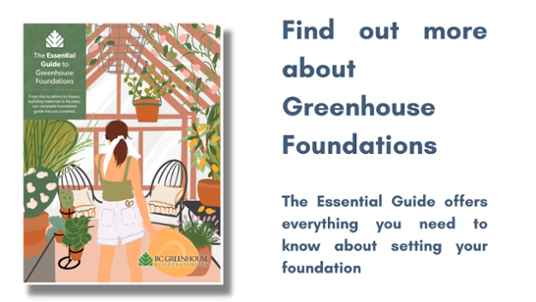Quick Answer:
Designing your ideal greenhouse involves selecting a color that complements your garden and reflects light effectively, building a raised foundation for better headroom and airflow, and choosing durable glazing like twinwall polycarbonate for energy efficiency—ensuring both aesthetic appeal and optimal plant growth.
When buying a new greenhouse, the big news is that whatever you choose, it is never big enough because as gardeners we know how to expand our production to fill our space. That is when my last greenhouse was 16' x 20' and I grew citrus trees in central beds, trays and trays of starter plants on suspended shelves, strawberries in rain troughs sitting on brackets attached to the walls, tomatoes in beds along the inside walls and cucumbers climbing a trellis to the really high roof.
The size and design of my new Cape Cod model BC Greenhouse Builders greenhouse is constrained by my new, smaller lot and the existing trees in place when I laid out the yard*. The final size of my new greenhouse is only 10' wide by 12' long.
%20and%20trees%20right%20as%20seen%20last%20May.jpg?width=687&height=515&name=My%20new%20back%20yard%20where%20I%20am%20squeezing%20in%20my%20Cape%20Cod%20between%20the%20garage%20(left)%20and%20trees%20right%20as%20seen%20last%20May.jpg) My new backyard where I am squeezing in my Cape Cod between the garage (left) and trees as seen last May.
My new backyard where I am squeezing in my Cape Cod between the garage (left) and trees as seen last May.
Other practical and aesthetic considerations to finalize my order with my Greenhouse Expert, Cassie, that I needed to make. I know the scale and model are right for me, but now I have to finalize the color, foundation, and what I will grow.
Greenhouse Color
A designer always chooses dark dramatic colors. I know this from all the designers I've hired and worked with. They want black clothes, they want walls painted in dark grey, and of course, they choose materials and accessories that are either black or in the case of BC Greenhouse Builders, they almost always select the very dark brown finish. Is the dark brown beautiful? Yes, it's gorgeous!
But color is an interesting decision and Cassie tells me I am not the only one who has trouble choosing. According to Cassie, men and designers often choose the dark brown option. Women often prefer white or green. My previous two greenhouses have been the standard green color and that seems to suit me best. It blends very well into the garden, looks black in some light angels, and is a pleasing color inside or out.
But again, with my large white garage, and because of the extra light I'll gain as the white reflects back onto the plants, I choose a white greenhouse. It will repeat a color I already have and it will also look elegant.
Greenhouse Foundation
While you can't place a BC Greenhouse Builders greenhouse directly on the ground, as long as your yard is level and your greenhouse is below 8' x 12' in size you can place it on a 2x4 wooden foundation. I have always had mine on a bit of a raised foundation and the foundation is getting taller with each new greenhouse. My first greenhouse had a 10" knee wall, then 17" and now this new greenhouse will be at 20". I do this because I want the extra "headroom" to grow taller plants including tomatoes and cucumbers. And a higher greenhouse will allow heat to rise up to the canopy where it will escape out of the automatically opening roof vents during super sunny days. (These vents are standard in all BC Greenhouse Builders greenhouses.)
If you hate climbing up to get into a hot tub, you'll hate climbing or stepping up over a greenhouse sill. To bring your wheelbarrow straight into the greenhouse on a level path but get extra headroom inside the greenhouse, simply request a door drop to suit the foundation height. This means the greenhouse frame sites above the ground at foundation height but the door sites on grade so there is no jarring difference as you walk from your garden into your greenhouse. This allows the overall greenhouse to be taller and leaves room for those really tall rambling, indeterminant tomatoes to reach for the roof.
The ridge height at the front and back of my greenhouse is 11' including the added height of the 20" foundation. When a friend, Laurie, put in a 20" foundation her friends said it looked too tall. They thought the greenhouse seemed like it was sticking out of the ground too much. But here's where landscaping comes in. Laurie added foundation plants that give color and interest in the seasons when the greenhouse is "off-season". Dwarf evergreens like Pumila spruce are hardy from zones 3-10. Or in the early spring, when you really need color, but pots of tell tulips in full bloom and set the pots between the evergreens.
So I choose a higher, 20" door drop. The greenhouse will be 20" taller at the ridge height than if it was built right on the ground. It still won't be as high as my garage height, but it'll be high and I'm ready for that. So, Cassie has my greenhouse redrawn.
When my small greenhouse was built, we used treated lumber as a foundation. When we moved it, we built the foundation with cinder blocks. My big greenhouse was placed on a poured concrete foundation. I get an offer of cheap blocks, so my new greenhouse will be set on a cinder block foundation. "Helpful husband" found this the easiest foundation to do by himself in the past and he is 20 years older now than when he built my first greenhouse.
In bad news? My big greenhouse will leave home as early as April. But we expect frozen soil in Alberta until Late April, so we won't be able to start putting up the foundation and greenhouse in our colder climate until May. I had my greenhouse last fall, but life got in the way and we didn't get the new foundation built before winter.
Greenhouse Glazing
The really cheap greenhouse or even the hoop houses that you see covered with polyethylene, the thin plastic, is a nightmare, so stay away from that. I definitely would not suggest that type of greenhouse for anyone's growing needs. It just flaps in the wind and the noise drives you crazy. It also needs replacing often so if you didn't just finish installing it, you'll have to do it soon. This is not easy or sustainable.
Of course, with BC Greenhouse Builders greenhouses, polyethylene plastic isn't even an option. The two main choices are polycarbonate and glass. There are different numbers of layers of both materials and the more layers you have the warmer it'll stay in the greenhouse. But the thicker the glazing, the harder it is for light to enter your greenhouse, so I've chosen the Twinwall polycarbonate as my main covering or "glazing" as it is known.
Polycarbonate lasts about 30 years and it's easy for growing because the light gets refracted, so it doesn't burn holes in plants where a drop of water sites on its leaf.
Polycarbonate is an easy system for growing but the more sophisticated, classy look comes with clear glass - it just looks fancy. But some glass has gotten really expensive lately, and I think it's overrated. It's not actually as warm inside a single glass greenhouse as it is inside a twinwall polycarbonate greenhouse at night, so I have only put glass in one location in my new greenhouse. Glass is at the end wall that I can see from my kitchen window because I want to be able to peek and see what is going on and get inspired by the color, the green, and the life. So, for me, the most visible wall in my new greenhouse is glass.
What Will I Grow
My new greenhouse will be completely different from my old greenhouses. I’m simply not planning to grow as much as I do in my current space. I currently use both the 16 x 20 and the 8 x 12 greenhouses for a total of 416 square feet of growing space plus the growing room on shelves and rain gutters and grow bags that get moved around to make space seasonally.

I have over 600 square feet of growing space between my two greenhouses where I grow strawberries in rain gutters and lettuce, tomatoes in the grounds. Tomatoes are started in flats and moved into the ground and lemon cuttings quickly become small lemon trees.


Large beefstake tomatoes grown in my greenhouse make fabulous summer sandwiches

This lemon growing in a growbag in my small greenhouse this week is three years old and will have 50 lemons this year.

I currently grow over 100 lemon cuttings into small trees in my greenhouse every year
Last year, I started and sold 800 tomatoes in the spring. Over the last few years, I’ve propagated and sold hundreds of lemons, figs, strawberries, grape vines and flower and vegetable starts in the winter season for spring sales and still made room for my own food crops in between. Greenhouse growing has been busy and humming with crops always coming and going.
In my new greenhouse, I’ll only have 120 square feet for growing but may only use half of that. Pride of place will go to a couple of comfy chairs with room for lamps, a table and cushions. I hope to have maybe four tomatoes and pots of plants grown in the coziness of my “greenhouse living room”. It will be less production and more comfort and joy. Or at least that is the plan right now. I did just start a couple of hundred pollinator plants for my daughter this spring and who knows what else she’ll need in future years!
What Next
My large greenhouse goes to its new home in April, my oldest 8 x 12 greenhouse will stay in my Vancouver Island backyard, and my newest greenhouse will be installed in May or early June in Calgary.
I am looking forward to continuing to share plants with friends and family, lighting a few candles and sharing some deep, Wi-Fi-free conversations. Everyone welcome.
PS Look for Parts 3 and 4 of this greenhouse adventure in May and June as we build and populate our greenhouse.
*After the greenhouse design is finalized and ordered, two trees blow over and have to be removed from my lot. This opened up a wider space, but I believe my greenhouse is right-sized for my yard and I am just happy the trees didn’t blow over after I installed my greenhouse. I will design a small garden to fill the now-empty spot left vacant besides the proposed greenhouse location.
** I know most gardeners decide what to grow before they choose their design. I know I will fill whatever space I get with whatever I like and can squeeze in, so I know it will be fun, whatever I grow.
More from Donna
 For more great tips from Donna, visit www.donnabalzer.com. You can also read Donna's gardening books: "No Gruff Vegetable Gardening with Steven Biggs" and keep track of your success with her "Gardener's Gratitude Journal: Part Diary, Part Personal Growing Guide".
For more great tips from Donna, visit www.donnabalzer.com. You can also read Donna's gardening books: "No Gruff Vegetable Gardening with Steven Biggs" and keep track of your success with her "Gardener's Gratitude Journal: Part Diary, Part Personal Growing Guide".




